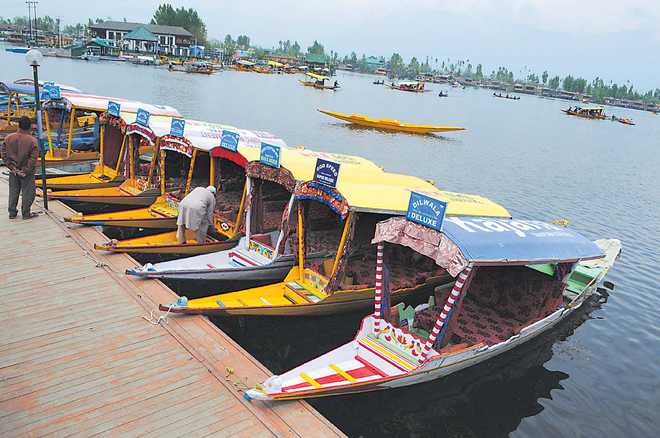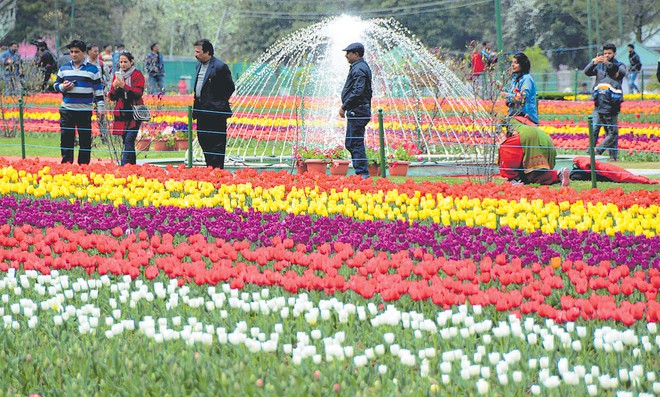The impact of terrorism on tourist footfalls has impacted the economy of Jammu and Kashmir. The more isolated the state remains, the greater is the danger of it turning into a fertile ground for sowing seeds of separatism.

IDYLLIC NO MORE: A row of shikaras awaits customers.

Asia’s largest tulip garden in Srinagar was thrown open for the public. PTI
WE have been travel writers for more than 40 years. During the first 13 years, we visited Kashmir a number of times, criss-crossing the state, writing about our encounters. Once, we even took along our TV team, driving “from Kashmir’s beautiful Srinagar, 85 kilometres to the frontier town of Sonamarg. This is the start of an exciting one-and-a half day road journey covering the 350 rugged kilometres over the Great Himalayas and the Trans-Himalayan Zanskar, stopping at the 3,450 m high Zoji-La, before descending into the starkly beautiful hills of Ladakh.” We have adapted this from the commentary of our television series, “Looking Beyond”. Not once, on that long road journey did we encounter any unrest. Unrest in Kashmir did not begin in 1977. We don’t need to conjure up our, possibly, fallible memories to relive a travel experience. They have been written about, passed the eagle-eyed test of editors, published, and then archived by us. In the Indian Express on March 31, 1979, we wrote: “There is no doubt that Jammu and Kashmir is the one state where the government and people alike are conscious of tourism as the world’s greatest industry and the only one that, by its very nature, preserves a heritage.” Clearly, there was no civic unrest in Jammu and Kashmir then though there seems to have been another outbreak of the jingoism that sweeps over some political parties in Maharashtra periodically. A journalist acquaintance from Mumbai said that the Free Press Journal (FPJ) had found our piece in the Indian Express interesting and would welcome something similar. On July 14, 1979, the FPJ carried our, presumably soothing, words on prickly-heated Mumbaikars when we said: “But if anyone wants to assess the impact of tourism they should look at Kashmir. Here is a ruggedly individualistic people, rich in traditions, culture and handicrafts, determined to retain the qualities that make them what they are. … And yet tourism is not only Kashmir’s major industry but it is also under the direct control of Sheikh Mohmmed Abdullah: the Chief Minister of Kashmir as also the Tourism Minister.”Obviously, even in July 1979, there was no unrest in Jammu and Kashmir.In fact, Kashmir’s tourism kept pace with the diverse needs of its visitors. We had begun to contribute to a magazine once edited by Khushwant Singh: New Delhi. In its issue of April 21-June 10, 1981, we wrote: “After years of tourism development, the resorts of Kashmir have begun to specialise in various types of travellers. Gulmarg is still, largely, the scotch, skiing and golf resort. Sonamarg is ponies, plaits and plimsolls. Pahalgam is for the family.” Resorts do not specialise unless they are assured of repeat clients, and repeat clients demand security, shun unrest. Kashmir was a safe destination in 1981.When we fast-forward to May 20, 1984, however, we get a hint of looming problems for Jammu and Kashmir Tourism. We had been invited to Srinagar for the annual conference of the Travel Agents Association of India. In our Op-ed Indian Express column, we wrote: “Dr Farooq Abdullah asked for more Indian Airlines support to bring tourists to Kashmir as long as disturbed conditions prevailed along the land route to the state. To the best of our knowledge no delegate encountered any of the widely reported civil strife problems allegedly affecting the state.”These widely reported civil strife problems seemed to be nothing more than biased, and possibly motivated, reports. After the conference, we drove from Srinagar to Yusmarg. There we interviewed a family of Gujjar shepherds. They did not speak of terrorists or civil strife but of another bogey. As we wrote on September 6 in The Hindu, “The people here call them Rantas and they say they come out when the wind blows chill and the snow begins to fall on the high mountains.” Yetis or Abominable Snowmen might be the stuff of nightmares but they are still unreal, not motivated and paid, AK- 47-toting, terrorists.We did, however, sense that events in the world beyond the mountains had begun to have an impact on this idyllic Valley. We began to probe, ask questions, seek statistics. Tourist inflows had declined. The sustained unrest in Punjab had had a sapping effect on tourism. And since tourism had assumed prime importance, its decline had resulted in a shrinking of glamorous jobs for its ambitious youth. As Abraham Maslow, the behavioural scientist, had predicted in his model of “hierarchy of needs”, once your lesser needs have been fulfilled the higher needs become your obsession.Consider the child of a shepherd, farmer, muleteer, porter or craftsman. He has seen the backbreaking toil his parents and grandparents had had to endure; he has tasted the good life, the glamour and fairly easy money of tourism. That is the development he craves. But the people of the plains have allegedly stopped tourists from coming to Kashmir. In the eternal highland-lowland dichotomy, he begins to resent those uncouth lowlanders and all that they stand for. It is easy for us, as a couple whose home is now in the highlands of the Himalayas but who were born in the plains of Bihar and Gujarat, to relate to their anguish. By snuffing out tourism in the Valley, and blaming “outsiders” for allegedly imposing their alien culture on Kashmiris, separatists and their handlers create disaffected youth: fertile ground for sowing the delusionary heroic glamour of the sponsored stone and the gifted gun. The Gantzers are Musoorie-based travel writers.
